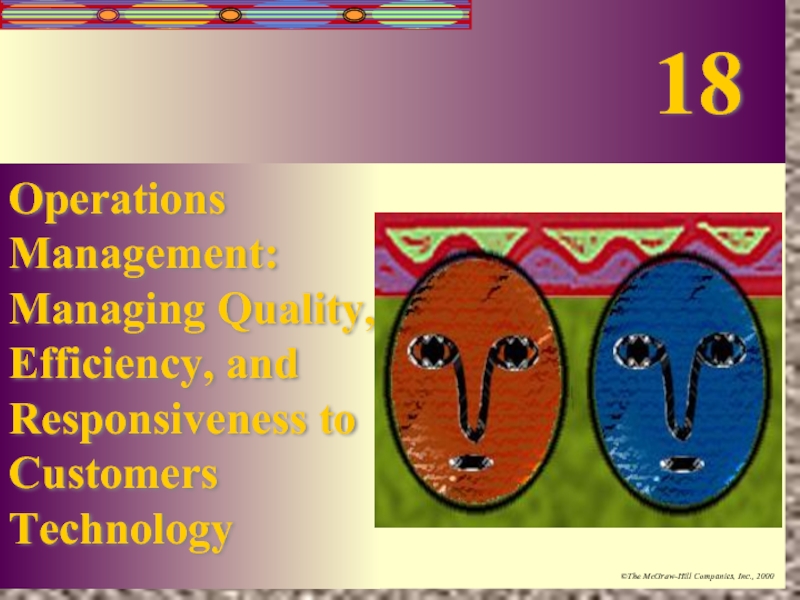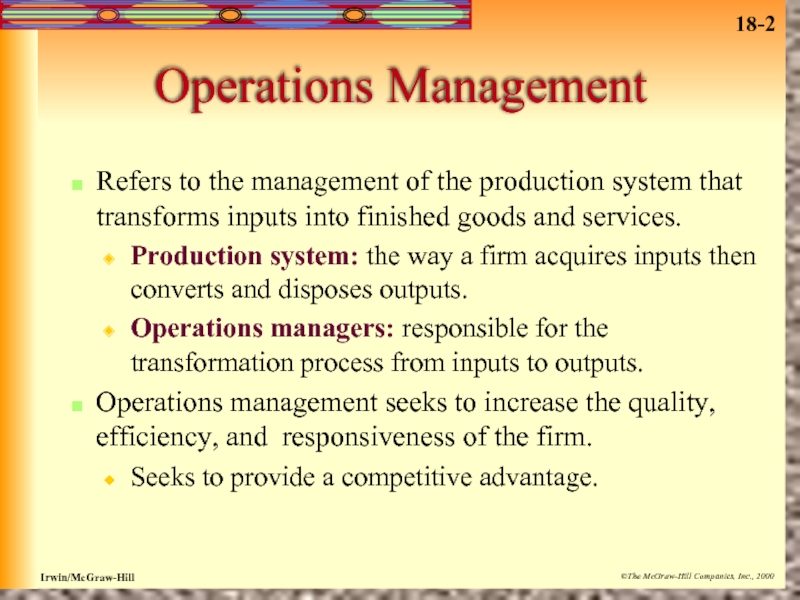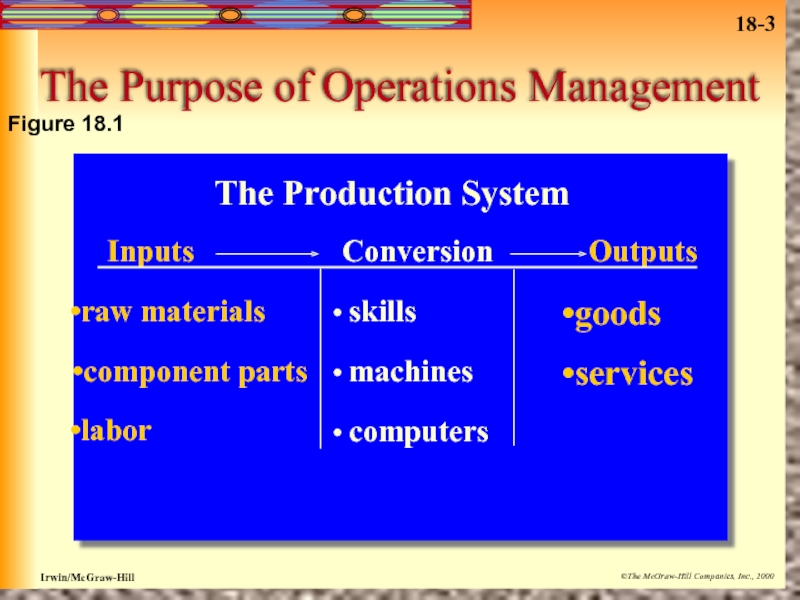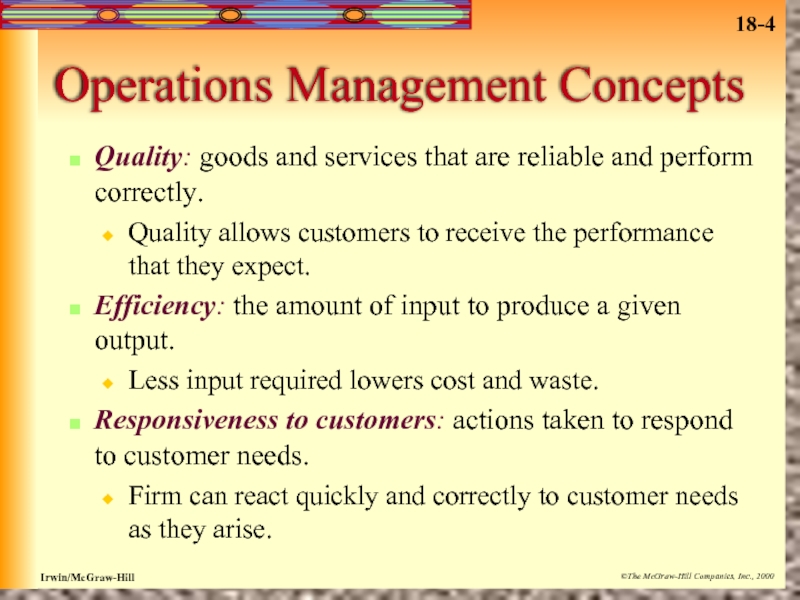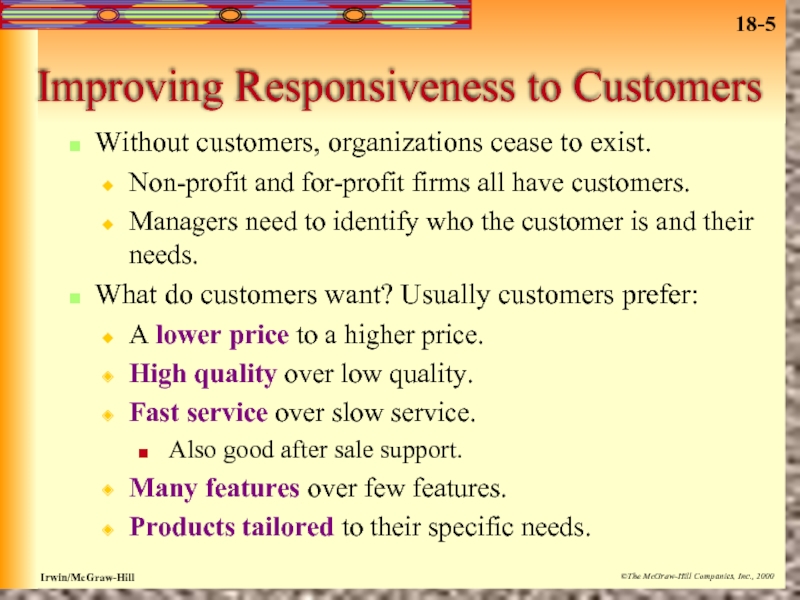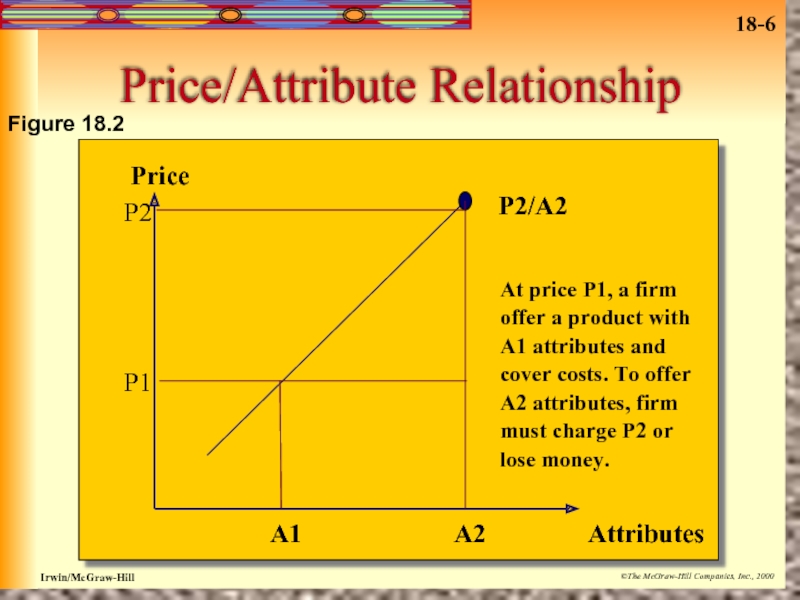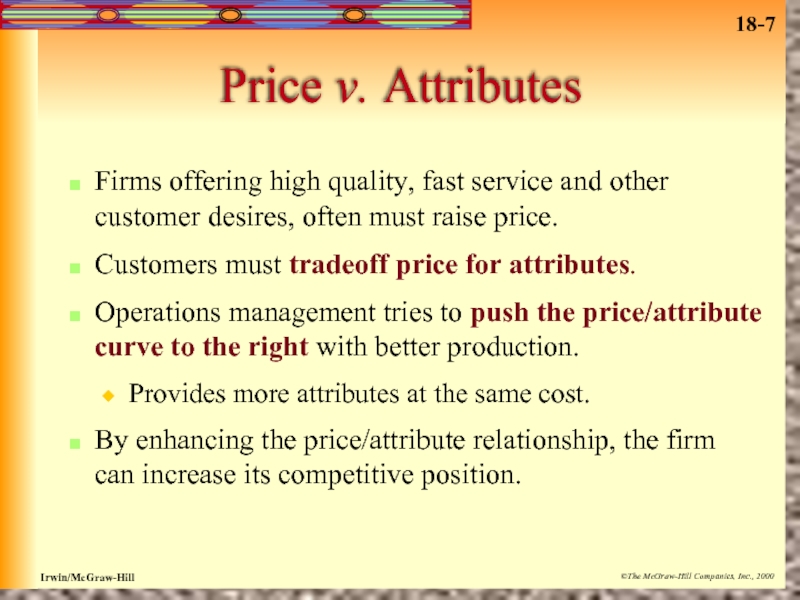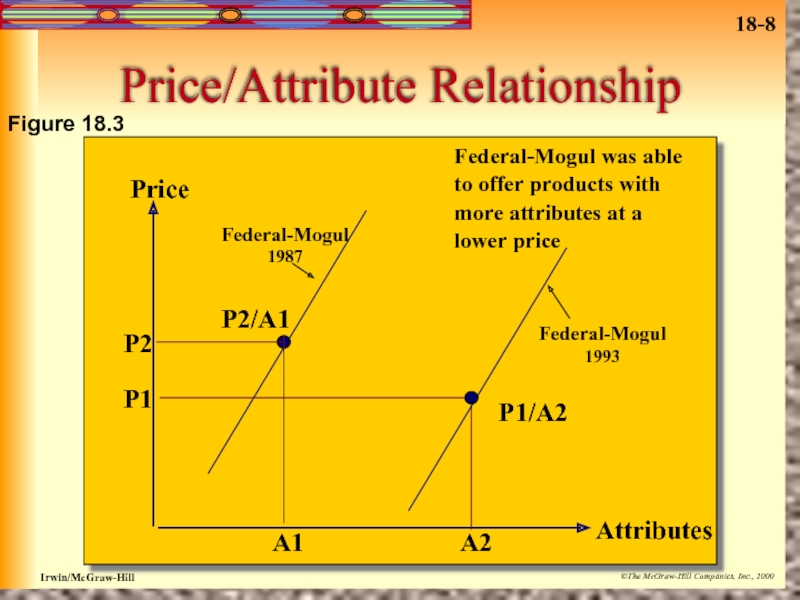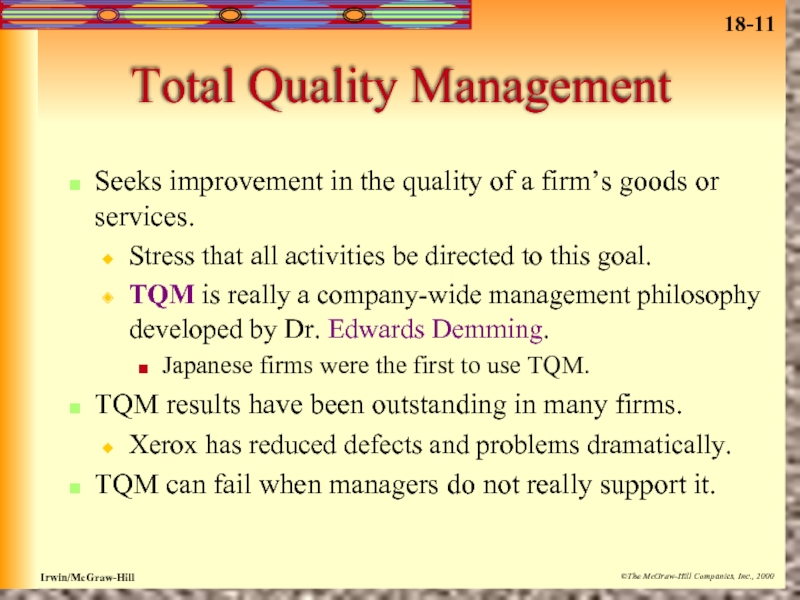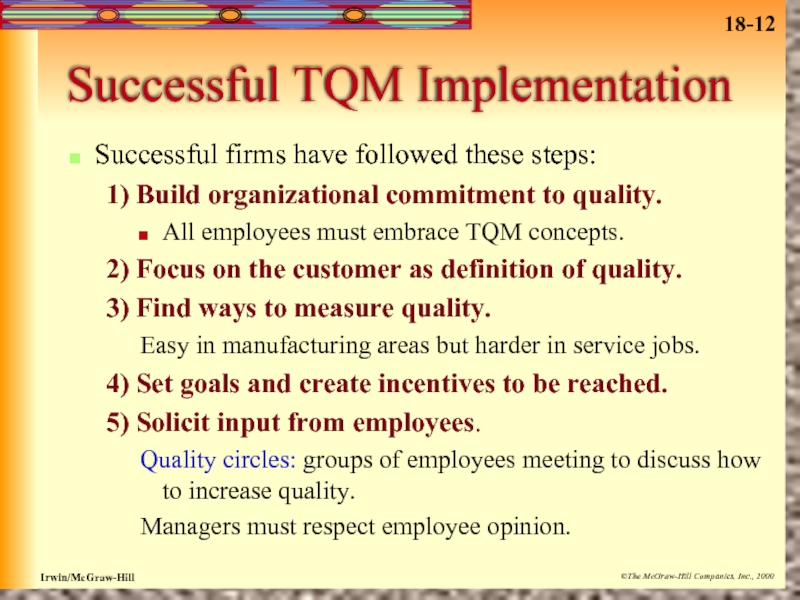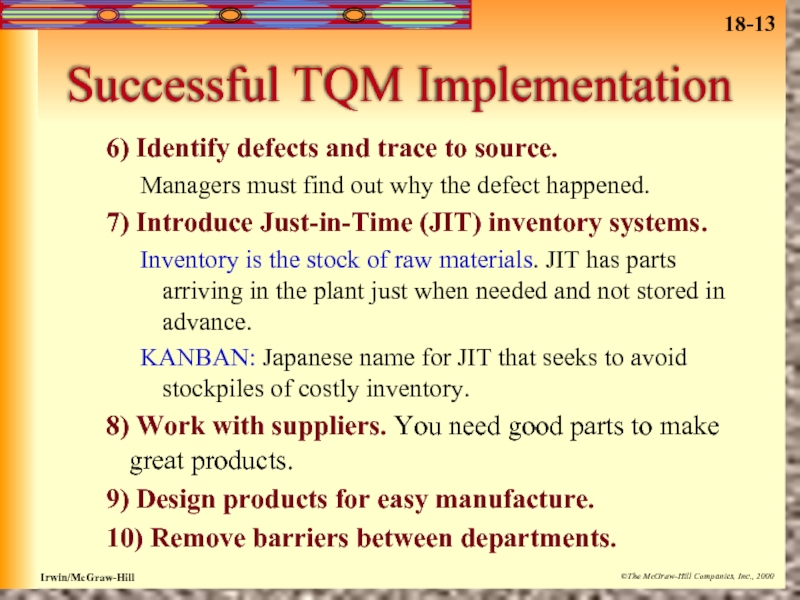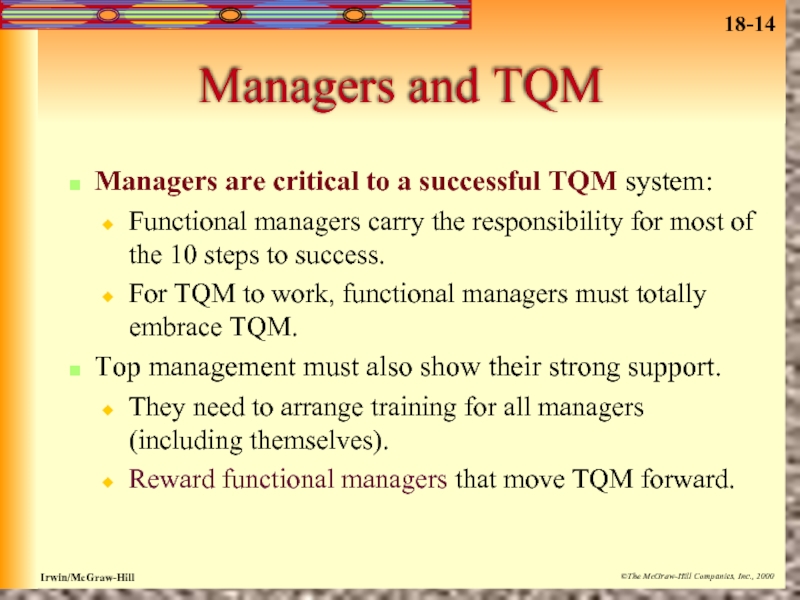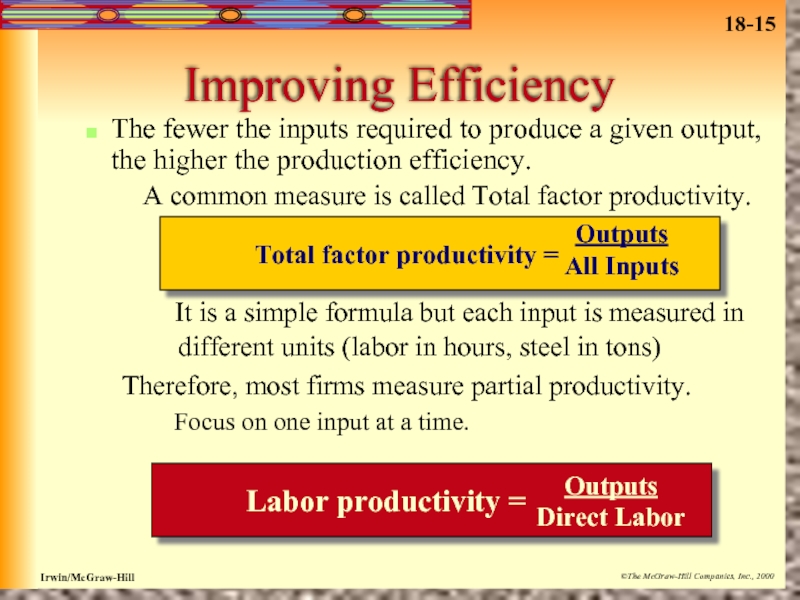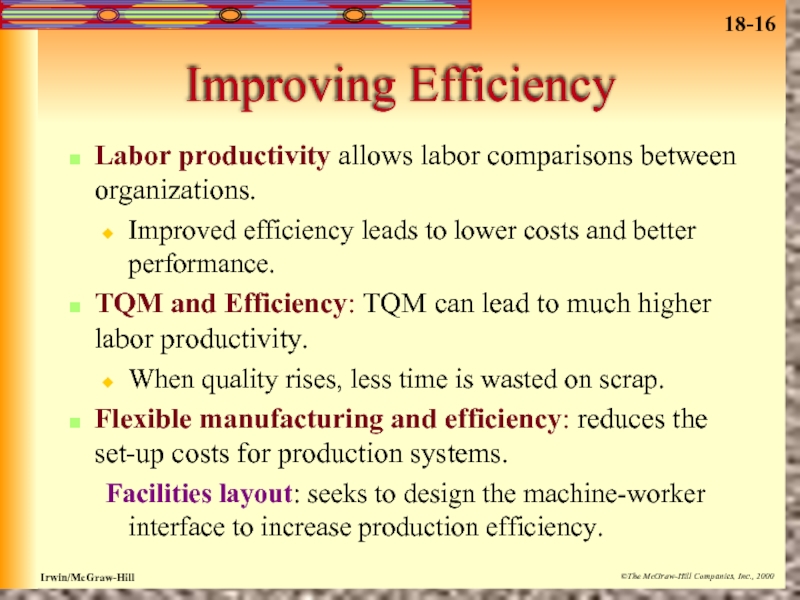- Главная
- Разное
- Дизайн
- Бизнес и предпринимательство
- Аналитика
- Образование
- Развлечения
- Красота и здоровье
- Финансы
- Государство
- Путешествия
- Спорт
- Недвижимость
- Армия
- Графика
- Культурология
- Еда и кулинария
- Лингвистика
- Английский язык
- Астрономия
- Алгебра
- Биология
- География
- Детские презентации
- Информатика
- История
- Литература
- Маркетинг
- Математика
- Медицина
- Менеджмент
- Музыка
- МХК
- Немецкий язык
- ОБЖ
- Обществознание
- Окружающий мир
- Педагогика
- Русский язык
- Технология
- Физика
- Философия
- Химия
- Шаблоны, картинки для презентаций
- Экология
- Экономика
- Юриспруденция
Operations management. Managing quality, efficiency, and responsiveness to customers technology. (Session 8.18) презентация
Содержание
- 1. Operations management. Managing quality, efficiency, and responsiveness to customers technology. (Session 8.18)
- 2. Operations Management Refers to the management of
- 3. The Purpose of Operations Management Figure 18.1
- 4. Operations Management Concepts Quality: goods and services
- 5. Improving Responsiveness to Customers Without customers, organizations
- 6. Price/Attribute Relationship Figure 18.2
- 7. Price v. Attributes Firms offering high quality,
- 8. Price/Attribute Relationship Figure 18.3
- 9. Customer Responsive Production Systems An output’s attributes
- 10. Impact of Increased Quality on Organizational Performance Figure 18.4
- 11. Total Quality Management Seeks improvement in the
- 12. Successful TQM Implementation Successful firms have followed
- 13. Successful TQM Implementation 6) Identify defects and
- 14. Managers and TQM Managers are critical to
- 15. The fewer the inputs required to produce
- 16. Improving Efficiency Labor productivity allows labor comparisons
Слайд 1
Operations Management:
Managing Quality, Efficiency, and Responsiveness to Customers Technology
18
Слайд 2Operations Management
Refers to the management of the production system that transforms
inputs into finished goods and services.
Production system: the way a firm acquires inputs then converts and disposes outputs.
Operations managers: responsible for the transformation process from inputs to outputs.
Operations management seeks to increase the quality, efficiency, and responsiveness of the firm.
Seeks to provide a competitive advantage.
Production system: the way a firm acquires inputs then converts and disposes outputs.
Operations managers: responsible for the transformation process from inputs to outputs.
Operations management seeks to increase the quality, efficiency, and responsiveness of the firm.
Seeks to provide a competitive advantage.
Слайд 4Operations Management Concepts
Quality: goods and services that are reliable and perform
correctly.
Quality allows customers to receive the performance that they expect.
Efficiency: the amount of input to produce a given output.
Less input required lowers cost and waste.
Responsiveness to customers: actions taken to respond to customer needs.
Firm can react quickly and correctly to customer needs as they arise.
Quality allows customers to receive the performance that they expect.
Efficiency: the amount of input to produce a given output.
Less input required lowers cost and waste.
Responsiveness to customers: actions taken to respond to customer needs.
Firm can react quickly and correctly to customer needs as they arise.
Слайд 5Improving Responsiveness to Customers
Without customers, organizations cease to exist.
Non-profit and for-profit
firms all have customers.
Managers need to identify who the customer is and their needs.
What do customers want? Usually customers prefer:
A lower price to a higher price.
High quality over low quality.
Fast service over slow service.
Also good after sale support.
Many features over few features.
Products tailored to their specific needs.
Managers need to identify who the customer is and their needs.
What do customers want? Usually customers prefer:
A lower price to a higher price.
High quality over low quality.
Fast service over slow service.
Also good after sale support.
Many features over few features.
Products tailored to their specific needs.
Слайд 7Price v. Attributes
Firms offering high quality, fast service and other customer
desires, often must raise price.
Customers must tradeoff price for attributes.
Operations management tries to push the price/attribute curve to the right with better production.
Provides more attributes at the same cost.
By enhancing the price/attribute relationship, the firm can increase its competitive position.
Customers must tradeoff price for attributes.
Operations management tries to push the price/attribute curve to the right with better production.
Provides more attributes at the same cost.
By enhancing the price/attribute relationship, the firm can increase its competitive position.
Слайд 9Customer Responsive Production Systems
An output’s attributes is determined by the production
system.
Firms must strike a balance between cost and attributes
Improving Quality: can apply to firms producing goods and services.
A firm that provides higher quality than others at the same price is more responsive to customers.
Higher quality can also lead to better efficiency.
Lowers waste levels and operating costs.
Firms must strike a balance between cost and attributes
Improving Quality: can apply to firms producing goods and services.
A firm that provides higher quality than others at the same price is more responsive to customers.
Higher quality can also lead to better efficiency.
Lowers waste levels and operating costs.
Слайд 11Total Quality Management
Seeks improvement in the quality of a firm’s goods
or services.
Stress that all activities be directed to this goal.
TQM is really a company-wide management philosophy developed by Dr. Edwards Demming.
Japanese firms were the first to use TQM.
TQM results have been outstanding in many firms.
Xerox has reduced defects and problems dramatically.
TQM can fail when managers do not really support it.
Stress that all activities be directed to this goal.
TQM is really a company-wide management philosophy developed by Dr. Edwards Demming.
Japanese firms were the first to use TQM.
TQM results have been outstanding in many firms.
Xerox has reduced defects and problems dramatically.
TQM can fail when managers do not really support it.
Слайд 12Successful TQM Implementation
Successful firms have followed these steps:
1) Build organizational commitment
to quality.
All employees must embrace TQM concepts.
2) Focus on the customer as definition of quality.
3) Find ways to measure quality.
Easy in manufacturing areas but harder in service jobs.
4) Set goals and create incentives to be reached.
5) Solicit input from employees.
Quality circles: groups of employees meeting to discuss how to increase quality.
Managers must respect employee opinion.
All employees must embrace TQM concepts.
2) Focus on the customer as definition of quality.
3) Find ways to measure quality.
Easy in manufacturing areas but harder in service jobs.
4) Set goals and create incentives to be reached.
5) Solicit input from employees.
Quality circles: groups of employees meeting to discuss how to increase quality.
Managers must respect employee opinion.
Слайд 13Successful TQM Implementation
6) Identify defects and trace to source.
Managers must find
out why the defect happened.
7) Introduce Just-in-Time (JIT) inventory systems.
Inventory is the stock of raw materials. JIT has parts arriving in the plant just when needed and not stored in advance.
KANBAN: Japanese name for JIT that seeks to avoid stockpiles of costly inventory.
8) Work with suppliers. You need good parts to make great products.
9) Design products for easy manufacture.
10) Remove barriers between departments.
7) Introduce Just-in-Time (JIT) inventory systems.
Inventory is the stock of raw materials. JIT has parts arriving in the plant just when needed and not stored in advance.
KANBAN: Japanese name for JIT that seeks to avoid stockpiles of costly inventory.
8) Work with suppliers. You need good parts to make great products.
9) Design products for easy manufacture.
10) Remove barriers between departments.
Слайд 14Managers and TQM
Managers are critical to a successful TQM system:
Functional managers
carry the responsibility for most of the 10 steps to success.
For TQM to work, functional managers must totally embrace TQM.
Top management must also show their strong support.
They need to arrange training for all managers (including themselves).
Reward functional managers that move TQM forward.
For TQM to work, functional managers must totally embrace TQM.
Top management must also show their strong support.
They need to arrange training for all managers (including themselves).
Reward functional managers that move TQM forward.
Слайд 15The fewer the inputs required to produce a given output, the
higher the production efficiency.
A common measure is called Total factor productivity.
It is a simple formula but each input is measured in different units (labor in hours, steel in tons)
Therefore, most firms measure partial productivity.
Focus on one input at a time.
A common measure is called Total factor productivity.
It is a simple formula but each input is measured in different units (labor in hours, steel in tons)
Therefore, most firms measure partial productivity.
Focus on one input at a time.
Improving Efficiency
Labor productivity =
Outputs
Direct Labor
Слайд 16Improving Efficiency
Labor productivity allows labor comparisons between organizations.
Improved efficiency leads to
lower costs and better performance.
TQM and Efficiency: TQM can lead to much higher labor productivity.
When quality rises, less time is wasted on scrap.
Flexible manufacturing and efficiency: reduces the set-up costs for production systems.
Facilities layout: seeks to design the machine-worker interface to increase production efficiency.
TQM and Efficiency: TQM can lead to much higher labor productivity.
When quality rises, less time is wasted on scrap.
Flexible manufacturing and efficiency: reduces the set-up costs for production systems.
Facilities layout: seeks to design the machine-worker interface to increase production efficiency.
